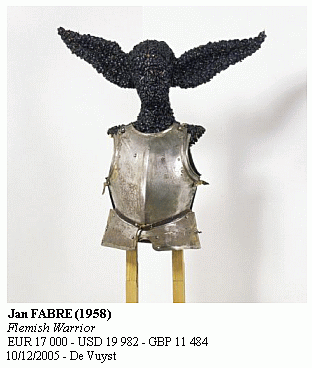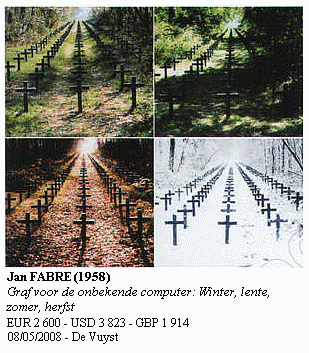Jan Fabre – Artist and entomologist
[13/07/2008]
Originally from in Anvers in Belgium, Jan Fabre developed a French connection via his fascination for the work of his namesake Jean-Henri Fabre (1823-1915) a 19th century entomologist and poet who described with tremendous accuracy and passion the life of insects, particularly beetles. Indeed, the iridescent carapace of beetles is a key material in the Jan Fabre’s work. Since 2002, the magnificent changing reflections of 1.4 million beetle shells decorate the ceiling of mirrors of the Royal Palace Brussels as part of his most impressive official order.
More recently, he celebrated his fiftieth birthday in the most prestigious museum in the world: Le Louvre. For three months (11 April 2008 – 7 July 2008) the museum organised an exceptional exhibition in which his works were placed in juxtaposition with the paintings of the grand masters of the Flemish Schools. As is often the case with Fabre’s manifestations, whether they be exhibitions, theatre, dance or performance, the Louvre exhibition was not without controversy. A petition entitled “Against the Jan Fabre exhibition at the Louvre” even arrived on the desk of France’s Minister for Culture, Ms Christine Albanel. As is often the case with “strong” works, Fabre excites passions and elicits controversy.

Outside Belgium, Fabre has achieved an international presence including at the Dokumenta in Kassel and the Venice Biennial, with solo exhibitions in Amsterdam, London, Barcelona, Warsaw and Munich before the Louvre exhibition in 2008. Considering his overall notoriety, the prices of his works are reasonable with 92% of the lots having sold for less than 10,000 euros.
His market is concentrated in Belgium (De Vuyst), Germany (Lempertz) and the Netherlands. For example, Sotheby’s included Fabre’s work in its Modern Art sales in Amsterdam. Last June, Sotheby’s offered a piece measuring 115 cm that consisted of an organic comma composed of bones and beetles, Fabre’s most favoured materials. Estimated at between 4 to 6 thousand euros, the piece was bought in despite the small number of his sculptures on the secondary market: not one had been brought to auction for two and a half years.
His first works in the public arena arrived timidly in 1992 with two drawings at De Vuyst and Campo & Campo. They sold for the equivalent of 830 euros and 1,000 euros. Five years later, Sotheby’s offered one of his ballpoint drawings – a technique that seems to attract higher prices than his inks – as part of its Contemporary and Modern Art sale in Amsterdam. This was his first real auction success: Sabel doubled its low estimated with the hammer falling at 5,255 euros. A year later, Sotheby’s presented two small installations representing insects, both of which sold for around 3,000 euros (Spider Sculptures, GBP 2,000 and GBP 2,200).
In 2003, for the first time, Fabre was included in a NY sales catalogue with a small ‘vanity’ made of resin and organic materials which sold for the equivalent of 2,300 euros at Phillips, De Pury & Luxembourg
However his presence on US and UK auction lists is only just beginning and his highest prices have so far been generated in Belgium: three sculptures were sold for between 10 and 20 thousand euros each at De Vuyst between 2001 and 2005, including Flemish Warrior composed of armour and a multitude of coloured beetles. The work changed hands in 2005 for €17,000 establishing the artist’s record auction price. Four years earlier, the same auctioneer had offered a similar work entitled Le chapelet du guerrier and consisting of the same materials. The piece sold for 500,000 Belgian francs, i.e. close to € 12,400.
The dearth of Fabre’s sculptures on the market is only occasionally compensated by sales of drawings, photos, paintings or prints. His blood drawings generate the highest prices.
A batch of 6 blood drawings from 1978 entitled My blood, my body, my landscape fetched €12,000 in December 2006 at De Vuyst). Since then, out of 8 Fabre works submitted for auction between March and June 2008, 5 were drawings including one collage presented in France (Massol): the small format (20 cm) representing a dung beetle failed to reach its estimate





 0
0
